Back to the Indie Corner series
I am so thrilled to share a conversation with Sharon Heath, author of the The Fleur Trilogy (Thomas Jacob Publishing, LLC) as well as a newer follow-up series, The Further Adventures of Fleur.
Mary: When did you get interested in writing eco-fiction, and what experiences inspired you?
Sharon: My interest in writing eco-fiction is rooted in both love and sorrow: a profound reverence for this miraculous Earth and an equally deep sadness and dread over what we humans are doing to our planet’s extraordinarily varied web of life. I was born and raised a city girl, living in various parts of California, but several early experiences awakened me to the numinous power of the natural world. The first occurred when I was little more than a toddler, standing one sunny day on the sidewalk in front of my Hermosa Beach home. Reaching out to stroke the beautiful green leaves of a nearby bush, I became suddenly aware of the-sun-shining-down-on-me-
Mary: Tell us about your background prior to becoming a writer.
Sharon: I was one of those bookish sorts of kids. Physically intimidated by most sports, overwhelmed by the deaths of five family members in my first five years, a social outcast whose politically leftwing parents were viewed as incarnations of the devil in 1950s America, and moved from school to school by a mom and dad who had the disconcerting habit of picking up stakes and relocating every couple of years. Thank goodness we were a family of readers! It was second nature to me to bury my nose in a book, seeking solace from loneliness and the trauma of too much accumulated loss. Early on, I fancied that writing stories for others to enjoy and lose themselves in would be the most wonderful thing in the world, but the depth of my childhood depression was such that I knew I didn’t have the imagination to come up with my own original tales. (I’ve learned since then that, in childhood trauma, the imagination is the first part of the young psyche to take the hit.) Fast forward decades, after finally mining that early trauma and melancholy in a Jungian analysis and eventually becoming an analyst myself, my imagination was freed from her emotional prison. With a newly born determination, I reached toward that early longing to write stories. It was tremendously difficult in the beginning. Day after day, I could manage only about thirty minutes’ worth of writing before collapsing in exhaustion. But the sense of liberation and the astonishment that my characters were assuming lives of their own that transcended my conscious intentions were thrilling enough to keep me at it. My writing gradually became more supple, more resilient, more an integrated feature of my own life, and it became—and remains—one of my primary sources of emotional sustenance, fascination, and play.
Mary: Do you have any unique experiences since you became an author?
Sharon: Becoming an author has stretched my horizons immeasurably, not only into the realm of the creative unconscious. My books have built bridges of engagement with a worldwide community of environmental activists, some of the finest souls I’ve ever encountered. I love visiting book clubs, either in person or virtually, and in discussing my books with scientists and housewives, young moms and retired seniors, it’s been my great delight to discover how stories are such a uniting language. When a reader tells me they cried over what happened to one of my characters or understood something about themselves for the first time through reading one of my books, I’m moved beyond measure. What is this life about, anyway, but connection? Finding my writer’s voice has made me aware of my own small but needed place in the vast and marvelous scheme of things. That’s one of the primary themes of The Mysterious Composition of Tears, in which my protagonist Fleur comes away from her cosmic sojourn with some of history’s finest thinkers with the message that each of us puny humans makes a necessary difference in the great unfolding of spirit and matter.
Mary: You have two series, though one is getting started. Can you talk about the first series, Fleur?
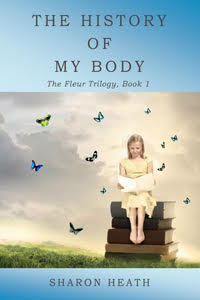 Sharon: The Fleur Trilogy (The History of My Body, Tizita, and Return of the Butterfly) features the development of Fleur Robins, whose anxious response to early trauma in a household presided over by an alcoholic mother and an anti-abortionist senator father, who hates actual children, weaves itself into an unusual giftedness that makes a significant impact on her world. In the coming-of-age, tragicomic novel The History of My Body, we encounter Fleur as an endearingly quirky child who brings a profound curiosity to the phenomenal world—admiring the tenacity of her favorite weed as it seeks water and sunlight, mourning the falling of rose leaves onto “their invisible flower beds,” raptly observing with her beloved grandfather the birds flitting back and forth between the limbs of “their” tree, the patterned ripples of light and shadow in a pool. But she’s also capable of paralyzing self-rejection, comically literal thinking, and is socially clueless, preferring the company of plants, cats, and adults like her Nana, who has the grip of a Mack truck, and her mother’s gassy companion, Sister Flatulencia, to other children. Fleur’s brilliance, flapping, and whirling lead some to wonder if she’s on the autistic spectrum. Or is she “just” a unique soul whose sensitivity, curiosity, and sense of awe and wonder defy categories, leading her to a precocious fascination with the butterfly effect, Fibonacci patterning, and what she calls “the void?” Fleur’s failures to save an abandoned baby bird on the lawn and to revive her dying grandfather propel her into putting her preoccupation with the void to good use. Thanks to the mentoring of an odd duck of a frog-faced physicist with a fondness for skipping and magic tricks, she makes discoveries that promise to ease humanity’s dependence on fossil fuels. But for all her brilliance, she’s still a young girl, losing her virginity in a moment of naïveté and learning the hard way to value the irreplaceable gift of friendship.
Sharon: The Fleur Trilogy (The History of My Body, Tizita, and Return of the Butterfly) features the development of Fleur Robins, whose anxious response to early trauma in a household presided over by an alcoholic mother and an anti-abortionist senator father, who hates actual children, weaves itself into an unusual giftedness that makes a significant impact on her world. In the coming-of-age, tragicomic novel The History of My Body, we encounter Fleur as an endearingly quirky child who brings a profound curiosity to the phenomenal world—admiring the tenacity of her favorite weed as it seeks water and sunlight, mourning the falling of rose leaves onto “their invisible flower beds,” raptly observing with her beloved grandfather the birds flitting back and forth between the limbs of “their” tree, the patterned ripples of light and shadow in a pool. But she’s also capable of paralyzing self-rejection, comically literal thinking, and is socially clueless, preferring the company of plants, cats, and adults like her Nana, who has the grip of a Mack truck, and her mother’s gassy companion, Sister Flatulencia, to other children. Fleur’s brilliance, flapping, and whirling lead some to wonder if she’s on the autistic spectrum. Or is she “just” a unique soul whose sensitivity, curiosity, and sense of awe and wonder defy categories, leading her to a precocious fascination with the butterfly effect, Fibonacci patterning, and what she calls “the void?” Fleur’s failures to save an abandoned baby bird on the lawn and to revive her dying grandfather propel her into putting her preoccupation with the void to good use. Thanks to the mentoring of an odd duck of a frog-faced physicist with a fondness for skipping and magic tricks, she makes discoveries that promise to ease humanity’s dependence on fossil fuels. But for all her brilliance, she’s still a young girl, losing her virginity in a moment of naïveté and learning the hard way to value the irreplaceable gift of friendship.
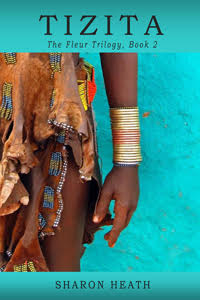 The second book of the series, Tizita, finds Fleur turning twenty-one and suffering the sweet tortures of first love. When her project to address the climate crisis is stalled by an anti-science congress, and her Ethiopian-born fiance Assefa takes off for Africa in search of his missing father, Fleur seeks consolation first at Jane Goodall’s Gombe Stream Chimpanzee Reserve and then on the grounds of an Ethiopian orphanage, where she encounters a rival for Assefa’s affections. She falls into a state described in Amharic as tizita—the interplay of memory, loss and longing—and her fate becomes marked by conflicts between science and religion, race and privilege, climate danger and denial, and sex and love.
The second book of the series, Tizita, finds Fleur turning twenty-one and suffering the sweet tortures of first love. When her project to address the climate crisis is stalled by an anti-science congress, and her Ethiopian-born fiance Assefa takes off for Africa in search of his missing father, Fleur seeks consolation first at Jane Goodall’s Gombe Stream Chimpanzee Reserve and then on the grounds of an Ethiopian orphanage, where she encounters a rival for Assefa’s affections. She falls into a state described in Amharic as tizita—the interplay of memory, loss and longing—and her fate becomes marked by conflicts between science and religion, race and privilege, climate danger and denial, and sex and love.
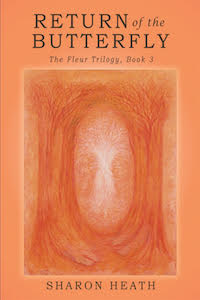
In the final book of the trilogy, Return of the Butterfly, we find Fleur a married woman who must ride rough waves of sexual betrayal and gender fluidity, and bullying and loss as she and her physics team speed up their efforts to ensure a viable future for the world’s children, including her own. She breaks through to new scientific ground thanks to her fascination with the void; a vivid imagination; a loving, if eccentric, extended family; and a couple of dogs named Hot Sauce and Good Time Charlie.
Mary: What’s going on in your newest series, The Further Adventures of Fleur? Do people need to read these books in order?
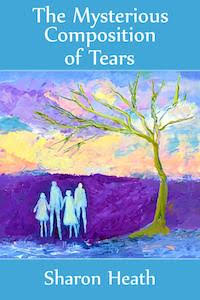 Sharon: I’ve recently released the first book of the planned sequel series, The Further Adventures of Fleur. I’ve written it as a stand-alone book, but it’s probably a richer read if one starts with The History of My Body (which establishes the uniquely zany and endearing flavor of protagonist Fleur) and moves chronologically forward. Set in 2032, The Mysterious Composition of Tears finds Fleur taking off into deep space after a series of climate calamities. The internet has crashed, fire and flood have devastated whole countries, and End-of-Times cults have proliferated. The good news is that nanoparticle holograms have replaced environmentally toxic electronic devices, young people are witnessing exquisitely colorful “Shimmers,” and the most gifted of them converse regularly with animals and trees. As her kinship group back on Earth strive mightily to bring her back home, she cavorts with the likes of the disembodied but nonetheless colorfully boisterous spirits of Albert Einstein, Wolfgang Pauli, Richard Feynman, seeking wisdom to bring back to a species seemingly hell-bent on destruction. Her resilient teenage children find ways to flourish and even fall in love in her absence, though their lives will be turned around by a mercurial figure who calls himself Dr. Nice, whose impact on their new friend Finn proves to have profoundly shocking consequences. Communion with animals and other life forms features prominently in all the Fleur books, but this time they speak with talking tortoises, bobcats, and trees contributing meaningfully to the story. The novel is a vision of what awaits us in a post-COVID world, a wild romp through quantum reality, and a deep sea dive into the dark and light vagaries of the human heart.
Sharon: I’ve recently released the first book of the planned sequel series, The Further Adventures of Fleur. I’ve written it as a stand-alone book, but it’s probably a richer read if one starts with The History of My Body (which establishes the uniquely zany and endearing flavor of protagonist Fleur) and moves chronologically forward. Set in 2032, The Mysterious Composition of Tears finds Fleur taking off into deep space after a series of climate calamities. The internet has crashed, fire and flood have devastated whole countries, and End-of-Times cults have proliferated. The good news is that nanoparticle holograms have replaced environmentally toxic electronic devices, young people are witnessing exquisitely colorful “Shimmers,” and the most gifted of them converse regularly with animals and trees. As her kinship group back on Earth strive mightily to bring her back home, she cavorts with the likes of the disembodied but nonetheless colorfully boisterous spirits of Albert Einstein, Wolfgang Pauli, Richard Feynman, seeking wisdom to bring back to a species seemingly hell-bent on destruction. Her resilient teenage children find ways to flourish and even fall in love in her absence, though their lives will be turned around by a mercurial figure who calls himself Dr. Nice, whose impact on their new friend Finn proves to have profoundly shocking consequences. Communion with animals and other life forms features prominently in all the Fleur books, but this time they speak with talking tortoises, bobcats, and trees contributing meaningfully to the story. The novel is a vision of what awaits us in a post-COVID world, a wild romp through quantum reality, and a deep sea dive into the dark and light vagaries of the human heart.
Mary: These books sound amazing, honestly! Your book covers are beautiful. Who is the artist, or is there more than one artist?
Sharon: I’ve been delighted to have unusually gifted artists contribute striking imagery to some of my eco-fiction book covers. David Schweitzer’s photo, Hamar Woman with Copper Bracelets, graces the cover of Tizita. At the age of ninety-nine, surrealist artist Sylvia Fein generously contributed her tempura painting Bound Together to the cover of Return of the Butterfly. And the extraordinary mythic artist Jeanie Tomanek created an original painting to evoke the haunting themes of The Mysterious Composition of Tears.
Mary: Anything else to add?
Sharon: I’ve been extraordinarily fortunate in this life to have been assigned two callings: the endlessly fascinating practice of Jungian analysis and writing fiction that feels guided by something larger than my conscious self that seeks to unite the Spirit of the Depths with the Spirit of the Times. The first words of each of my novels has come to me from out of the ether, often in a dream; I’m typically “given” the beginning of my novels and their endings. I’ve come to understand that my task is to track my characters as faithfully as possible as they evolve, devolve, grow, suffer, and impact one another (and me) as they move toward a novel’s conclusion. I see my creative imagination as a representative of the Earth herself, as well as the dying stars who birthed this big blue orb. I try to continually perfect my craft to do justice to these characters who are given to me. They feel absolutely real to me, and if one dies or suffers terribly, I’ve been known to spend days in grief. The work feels simultaneously sacred, playful, and incredibly challenging. I love every minute of it.
Mary: Incredible stuff, Sharon. Thanks so much!
About the Author
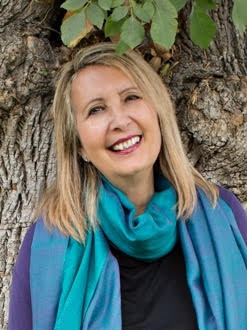 Sharon Heath, a Los Angeles native, is a Jungian analyst who’s passionate about writing fiction and non-fiction exploring the interplay of science and spirit, politics and pop culture. She’s an environmentalist, film fan, voracious reader of British crime fiction, yaya to two adorable grandchildren, and a certified (if not certifiable) cat lady. She blogs and offers excerpts from her novels and essays, as well as samplings from environmentalists, quantum physicists, and C.G. Jung, at www.sharonheath.com.
Sharon Heath, a Los Angeles native, is a Jungian analyst who’s passionate about writing fiction and non-fiction exploring the interplay of science and spirit, politics and pop culture. She’s an environmentalist, film fan, voracious reader of British crime fiction, yaya to two adorable grandchildren, and a certified (if not certifiable) cat lady. She blogs and offers excerpts from her novels and essays, as well as samplings from environmentalists, quantum physicists, and C.G. Jung, at www.sharonheath.com.